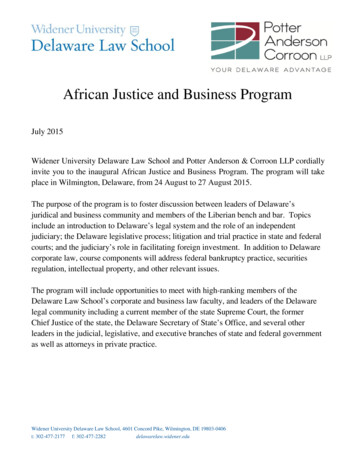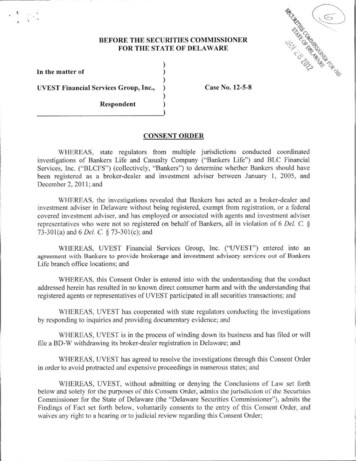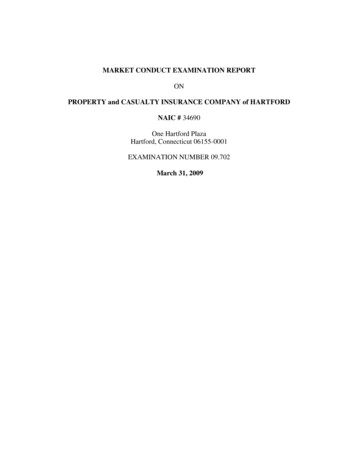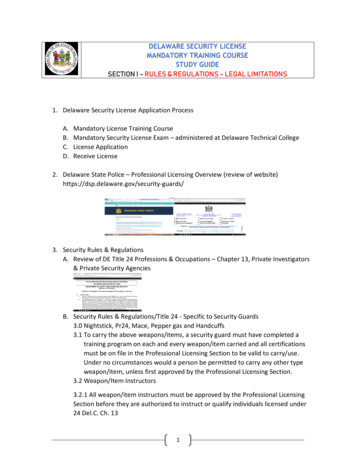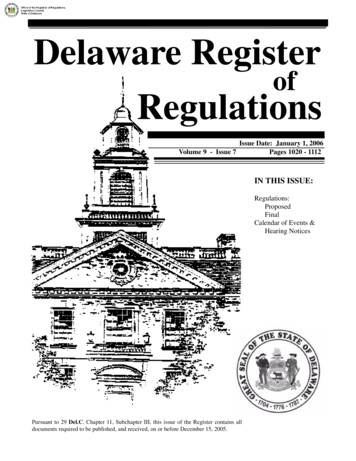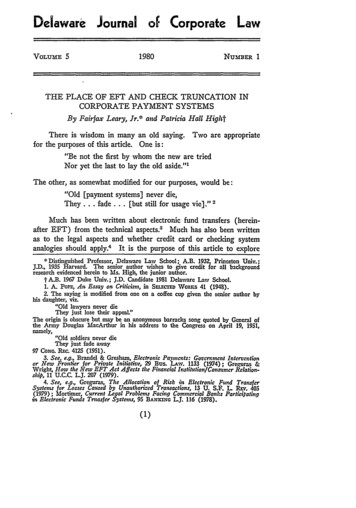
Transcription
Delaware Journal of Corporate LawVOLUME 51980NUMBER 1THE PLACE OF EFT AND CHECK TRUNCATION INCORPORATE PAYMENT SYSTEMSBy Fairfax Leary, Jr.* and PatriciaHall HightThere is wisdom in many an old saying. Two are appropriatefor the purposes of this article. One is:"Be not the first by whom the new are triedNor yet the last to lay the old aside."'The other, as somewhat modified for our purposes, would be:"Old [payment systems] never die,They .fade .[but still for usage vie]." 2Much has been written about electronic fund transfers (hereinafter EFT) from the technical aspects.' Much has also been writtenas to the legal aspects and whether credit card or checking systemanalogies should apply.4 It is the purpose of this article to explore* Distinguished Professor, Delaware Law School; A.B. 1932, Princeton Univ.;J.D., 1935 Harvard. The senior author wishes to give credit for all backgroundresearch evidenced herein to Ms. High, the junior author.t A.B. 1967 Duke Univ.; J.D. Candidate 1981 Delavare Law School.1. A. POPE, An Essay on Criticism, in SEsEcm ,Vonns 41 (1948).2. The saying is modified from one on a coffee cup given the senior author byhis daughter, viz."Old lawyers never dieThey just lose their appeal"The origin is obscure but may be an anonymous barracks song quoted by General ofthe Army Douglas MacArthur in his address to the Congress on April 19, 1951,namely,"Old soldiers never dieThey just fade away97 CoNG. REC. 4125 (1951).3. See, e.g., Brandel & Gresham, Electronic Pa.,ncnts: Government Interventionor New Frontier for Private Initiative, 29 Bus. LAW. 1133 (1974); Greguras &Wright, How the New EFT Act Affects the FinancialInstitution/ConstmerRelationship, 11 U.C.C. LJ. 207 (1979).4. See, e.g., Greguras, The Allocation of Risk in Electronic Fund TransferSystems for Losses Caused by Unauthorijed Transactions, 13 U. S.F. L REv. 405(1979); Mortimer, Current Legal Problems Facing Commercial Banks Participatingin Electronic Funds Trnasfer Systems, 95 BANKWNG L.J. 116 (1978).
DELAWARE JOURNAL OF CORPORATE LAW[VOL. 5the potential impact of EFT on both the corporate treasurer and thebanking system and to closely examine a voluntary system of corporatecheck truncation. Many of the writers describe the recent developmentsin free standing or through-the-wall electronic consumer-operatedterminals 5 as new and some as even revolutionary.0 But this is notreally so. From the corporate treasurer's as well as the bank officer'sviewpoint, the new consumer terminals are but a small addition toelectronic fund transfer systems that have existed in an overall payments system for many years. Even check truncation I at the bank offirst deposit is not a great change. 8I.HISTORICAL OVERVIEW OF PAYMENT SYSTEMSTo put the new and essentially minor changes in proper perspective, a bit of an historical introduction is necessary. While Sir HenryMaine's statement that the progress of the law is from "status tocontract" 9 may need some rethinking in light of today's trends towardgreater consumer protection, the progress in payment systems is notfrom a to b but seems to be by adding b to the existing a. Thus unitof value trading was added to pure barter, but bareter did not disappear." The early units of value tended to be standardized, or nearlystandardized, commodities such as cattle. But even with these commodities, variations in condition made the unit of value far fromuniform. Uniformity could, however, be easily obtained in preciousmetals. Therefore the use of precious metals by weight graduallytook the place of other commodities, and, in time, payments focused5. The terminals referred to, automated teller machines and cash dispensers(sometimes known as "magic money-machines"), are located throughout the UnitedStates in outer walls of bank buildings and off-site premises such as airports.6. See, e.g., Naar & Stein, EFTS: The Computer Revolution in ElectronicBanking, 5 RUTGERS J. Compmrrzs & L. 429 (1976); Schuman, EFTS Revolution-.King Kong in Search of a Trainer, 32 REC. 174 (1977).7. Check truncation involves "stopping the physical handling of checks at somephase of processing-and transmitting MICR (Magnetic Ink Character Recognition)data from checks . . . ." G. White, Assessing Check Truncation Opportunities, Burroughs Clearing House 11 (Sept. 1979).8. Credit unions have been truncating share drafts for some time, although notat banks of first deposit. The method used is known as intercept truncation. Theprocess accounts for roughly 14 million truncated items per month nationally. SeeComputer Model Shows S&Ls Could Cut Costs of Funds by Truncating Drafts,American Banker, February 21, 1979.9. H. MAINE, ANCIENT LAW 100 (1861).10. Barter is still alive and well on an international scale. For example,Professor Robert Weigand, head of the Dept. of Marketing at the University ofIllinois at Chicago Circle, reports that during the decade of the seventies Pakistansent cotton to Bangladesh in return for jute rather than currency. Likewise, PepsiCoof the United States bartered in syrup and services for Stohchmaya vodka in anagreement whereby PepsiCo supervised the bottling of its product throughout theSoviet Union. Weigand, International Trade Without Money, 55 HARV. Bus. RaV.28 (1977).
19801EFTAND CHECK TRUNCATIONon gold and silver of specified weight at a definite standard of finenessas units of value.But gold and silver, even when minted and stamped by the government as a unit of value of a stated amount, were not satisfactory,since paring reduced the actual quantity of metal, thereby reducingvalue. The invention of the milled edge made paring easily detectable,but did not reduce the many problems involved in the physical transportof coin: weight, exposure to theft, errors of counting, need for safestorage space, and the like.Fear of loss through carelessness, fire, or theft led to the depositof monies for safekeeping with cashiers in Holland and the Mint andgoldsmiths in England. Thereafter, the practice of lending againstdeposited funds was started. The depositaries thus became banks. Atfirst, deposits were evidenced by promissory notes of the bank ofdeposit payable to bearer."' These notes were issued in various denominations, and higher denominations were exchangeable for a likeface amount of other desired denominations.Parallel with the development of coinage, or perhaps earlier intime, was the development of the use of private debts as a means ofpayment. To illustrate, a merchant in one city and country wouldsell goods to a merchant in another country or place. Rather thanmove gold in the opposite direction from the movement of goods, themerchant seller would write an order to his debtor, who could be in afar away locale, to pay the value to a third person, or as ordered bythe third person. Disputes concerning these bills of exchange inEngland were first heard in the merchant courts of the great mercantile fairs, known as the Piepowder Courts.'Although English merchant law had a well-developed system ofnegotiable paper by the Seventeenth Century, the common law courtsexperienced great difficulty in giving effect to the law merchant.13 Thedifficulty culminated in Lord Holt's opinion in Buller v. Cripso4 inwhich it was held that promissory notes were nonnegotiable.11. By the middle of the Nineteenth Century, bank notes of various independentstate banks comprised almost the entire system of money in the United States. VeazieBank v. Fenno, 75 U.S. (8 Wall.) 533, 536 (1869).12. Strictly speaking, promissory notes came into usage before the bills ofexchange, during the Thirteenth Century in England. Buyers at the mercantile fairs-would give sellers their notes payable at another fair. Disputes concerning thesenotes were litigated in the Piepowder or Merchants' Courts, whose jurisdictionextented only to the particular fair in which they were held. By the SeventeenthCentury the bills of exchange had become established and enforceable in the StapleCourts and Courts of Admiralty, and were thereafter recognized in the law, courtsof England. See generally F. BEuTEL, BEUTEL's BRANNAN NErorIAME INsTmRUsILAw 1-29 (7th ed. 1948).13. See 8 W. HoLaswoRrH, Hisroay OF ENGLISH LAW (2d ed. 1937); 2 L STrE-r,FOUNDATIONS OF LEGAL LIAn.rry (1906).14. 87 Eng. Rep. 793 (K.B. 1704).
DELAWARE JOURNAL OF CORPORATE LAW[VOL. 5The resulting displeasure of the merchants over their inabilityto enforce as negotiable promissory notes which they had been recognizing as negotiable for over 400 years was a prime motivation forthe enactment of the Statute of Anne,15 which put promissory noteson an equal footing with bills of exchange. Lord Mansfield's liberalapproach to the absorption of the merchant law into the common lawwas reflected in his holdings in Miller v. Race10 and Grant v.Vaughan 7 in which both notes and bills of exchange were recognizedas enforceable negotiable paper."8The point is that the bill of exchange as negotiable paper wasrecognized in the common law and continues to be used as such. Itis found in the use of the documentary draft,' and the so-called documentary sale in which a seller prepares a paper order to his buyer topay the price, attaches a bill of lading covering the goods, and procuressome organization at the city of the buyer to present the papers andcollect the payment.20 It is found in letter of credit transactions, 2 'which seem to be on the increase.Although bills of exchange and letters of credit are still extremelyuseful, particularly for international trade, bank notes, due to theirexchangeability, are more desirable when the amount fixed for onetransaction is not inherently suitable for other transactions. Furthermore, the bank note enjoys the advantage of making credit risk evaluation easier than in the case of an individual's bill of exchange orpromissory note, since the credit risk of an institution is substitutedfor that of an individual. A drawback, however, to users is the bearercharacter of the bank note. While negotiability does not make finderskeepers, it does give the bearer of bank notes the power, but not theright, to create full ownership in an 22especial kind of bona fide purchaser called the holder in due course.15. Statute of Anne, 1704, 3 & 4 Ann., c. 8 (repealed by Bills of Exchange, 1882,45 & 46 Vict., c. 61, § 96).16. 97 Eng. Rep. 398 (K.B. 1758).17. 97 Eng. Rep. 947 (K.B. 1764).18. For a more detailed treatment of this subject, see F. BEUTE, supra note 12.19. See U.C.C. § 4-104(f).20. See U.C.C. §§2-320(4), 4-104(f), 4-501 to -503. While §2-320(4)requires payment without inspection by the buyer, U.C.C. §2-321(3) says "[u]nlessotherwise agreed ;" a contract term on or after arrival allows the buyer to inspectunless the goods are lost, in which case payment is required against the documents.21. See U.C.C. §§2-325, 5-101 to -117. While a C.I.F. term does not precludedishonor of the draft on presentment, a letter of credit is the issuing bank's independent and irrevocable promise to pay on presentment.22. See U.C.C. §3-302. Ever since Miller v. Race, 97 Eng. Rep. 398 (K.B.1758), the negotiable character of money has been established. It continues eventhough money is excluded from the coverage of Articles 3 and 4. See U.C.C.§§3-103(1), 4-102(1), 4-104(g).
1980]EFTAND CHECK TRUNCATIONIn the United States, prior to the Civil War, three media of payment predominated: negotiable notes or bills of exchange of privatebusinesses, state bank notes, and specie. This system might have remained intact longer were it not for the need to finance the UnionArmy, but the legislation taxing state bank notes had the unanticipatedsecondary effect of making more widespread the use of the check as amedium of paymentThe troubles with the transfer of private notes were and are threefold. One is the credit evaluation problem. This is lessened by theguaranty of every indorser of paper payable to order." Order paperalso has a lesser risk of ultimate loss through carelessness, since atrue owner, at least in Anglo-American law, can recover from thosetaking the instrument after a necessary indorsement has been forged."The very protection of the true owner just mentioned, however, causesthe second trouble, namely, a need of assurance that no prior indorsement in the chain leading to one taking the instrument was forged."The third trouble is that much of the private debt paper is time paper,not payable until a time certain in the future.21 Thus, one who acceptspaper of private individuals often has to find a buyer when it becomesdesirable to have money to pay. Of course, where a demand exists, amarket will be made, and there were and are note brokers; 2" but,note selling takes time, and time is money.The gradual realization of the time factor in the use of money,or to put it a bit differently, the realization that idle funds meant a23. The National Bank Act of 1864, ch. 106, § 41, 13 Stat. 99, among other things,imposed taxes on notes issued by state banks, the primary medium of exchange at thetime. See note 11 .rpra. Professor White has indicated that the need to finance the"war-torn Union" was probably a primary motivation for passage of the act, althoughSecretary of the Treasury Salmon P. Chase, among others, undoubtedly intended theact to have the effect of discouraging state bank notes and promoting the use of anational currency. Chasers wishes only partly became reality due to the expansion ofchecking accounts in the latter half of the Nineteenth Century. Thus, although statebank notes virtually disappeared because of the ten percent tax enacted in 1865,national currency accounted for less than ten percent of the nation's business transactions in the 1880's due to the use of bank-deposit credits (checks) as money. Seegenerally J.WHrr, BANKING LAW 18-23 (1976).24. See U.C.C. § 3-414.25. The recovery is in conversion. See U.C.C. § 3-419(1) (c). For a brief discussion of the rule in the Continental Law Systems, see Leary & Husted, AnApproach to Drafting an International Commercial Code and a Modus OperandiUnder Present Laws, 49 COLum L R-v. 1070, 1090 (1949).26. Such assurance consists of the indorsement warranty of the seller. SeeU.C.C. §3-417(2) and its companion, U.C.C. §4-207(2). made necessary becauseArticle 4's "item" includes non-negotiable paper. See U.C.C. §4-104(g).27. To the need for credit risk evaluation was added the need for a discountcalculation if the current market rate varied from the rate specified in the paper.28. The practice is recognized in the more limited warranty given by the disclosed note broker in U.C.C. §3-417(4). Significantly, this reduction in liabilityis not specifically afforded under U.C.C. § 4-207, but the § 4-207 warranties are notmade except by the depositor of an item for collection who is the defined "customer"mentioned. See U.C.C. §4-104(e).
DELAWARE JOURNAL OF CORPORATE LAW[VOL. 5monetary loss, and the above-mentioned threefold trouble with theuse of transferable private notes also encouraged the growth of theuse of transferable deposit balances as a medium of payment. Thegrowth, however fantastic the present volume of checks being processedmay seem, 29 has not driven out of use the Federal Reserve note, thebill of exchange, or the transferable promissory note, although the useof the latter has diminished greatly, due in part to the coming of ageof accounts receivable financing, so that sellers no longer need notesfrom their mercantile or consumer customers for financing purposes. 0II.THE CHECKING SYSTEM AS IT EXISTS TODAYPAPER AND ELECTRONIC TRANSMISSIONSWhatever the cause, the paper-based deposit credit transfer systemcaught on, and the number of check transactions is now truly staggering."' In essence, each check transaction consists of two elements:a message element and the account element or real transfer, triggeredby the message and consisting of a series of debits and credits throughan inter connected series of accounts which causes the amount of thecheck, debited from the payor's account, to come to rest as a credit tothe payee's account in the same or a different financial institution. Itis important to separate in our thinking the message element and theaccount element in a funds transfer. This is because in many checkoriginated transfers, the account element, due to computerized bookkeeping, has been wholly or partly in an electronic mode for someyears.3229. See text accompanying note 45 infra.30. The assignability of choses in action was a relatively late development inthe law. It is interesting to note that long after merchants took notes only fromcredits not good enough for open account dealings, banks shunned accounts receivableand accepted gladly the discount of notes and trade acceptances.31. See text accompanying note 45 infra. A very large California bank hasinformed the authors that three years ago it handled about two billion checks. Inthe process it moved about ten tons of paper every working day. One branch alonehas produced for it daily a stack of computer printouts six feet high. The banktransported some of the paper 800 miles overnight, requiring a fleet of nine aircraftwhich flew more than a million miles over eleven routes from the Mexican Border tothe Oregon state line. It also used more than 500 courier vans and cars to movethe materials between branches and airports, covering 471 routes and tallying over740,000 miles per month.California is, of course, a state-wide, or should we say, state-long, branchingstate. But the movement of paper is required whether it be between unit banks orlimited branching banks.32. U.C.C. §§4-109, 4-204(3) were added to the U.C.C. in 1962 to cover thethen-burgeoning uses of electronic check processing and bookkeeping. See U.C.C.§ 4-109, Comment, Example 3; U.C.C. §4-204, Comment 4. Computerized recordkeeping is now nearly universal, although still done at off-premises processinglocations for smaller institutions.
1980)EFT AND CHECK TRUNCATIONA. Processing Time Lags in the SystemIn considering the checking system, the concepts of conditionalor provisional and final credits to accounts must be understood. Tosimplify the bookkeeping, when checks are deposited to a creditor'saccount, a provisional credit is entered to that account. That amount,however, is not subject to withdrawal as of right until the check hascleared, i.e., until the check has been forwarded to the payor bank andNevertheless,a reasonable time for its return unpaid has elapsed.'are re1%ofalldepositedchecks1%and2ofsince only betweenturned unpaid,' only low balance or problem accounts are monitoredfor drawing against uncollected funds during the lag time betweendeposit and the day the funds become available for withdrawal as ofright. Thus, in many instances, a corporate depositor can play thefloat (i.e., draw against funds during the clearing time or draw checksin anticipation of deposits), by not depositing funds in its demand deposit account until, based on experience, the treasurer's departmentknows its checks will come home to be paid. In some cases the corporate treasurer knows that the process of posting ' of the draweebank will not reach the account-debiting stage until the day after thebank's physical receipt of the check. That delay is inherent in a delayed-posting bookkeeping practice."0 Thus, a covering deposit of good33. See U.C.C. §§4-213(4)-(5).See Rapp v. Dime Savings Bank, 64 App.Div. 2d 964, 408 N.Y.S.2d 540 (1978), reversing a lower court's holding that asavings bank's schedule of availability (and hence the starting of interest) ondeposits was unreasonably long and so violated §4-213(4). The Appellate Divisionsaid:[T]he record demonstrates that the time restrictions are reasonable andsubstantially related to the actual time period in which the Dime may expectto be notified that a check is uncollectible. That other banks may havesomewhat shorter time restrictions does not mean that their checks clearany faster. Rather, it means only that those institutions are willing toaccept the risk of loss at an earlier date.Id. at 969, 408 N.Y.S2d at 546.The Pennsylvania Savings Fund Society has clarified its position regarding timerestrictions by adopting a schedule of days to be allowed before payment orders maybe written against funds deposited by checks drawn on banks in various geographicalarea. Checks drawn on Philadelphia banks require five days; those drawn on banksin the rest of Pennsylvania, New York, New Jersey, or Delaware require sevendays; and fifteen days must be allowed when the bank is located elsewhere in theUnited States. Pennsylvania Savings Fund Society, How to Avoid UnnecessaryService Charges (1979).34. The figure is one for all checks. See 1 The Atlanta Payments Project,Research on Improvements of the Payments Mechanism, Phase I1 46-47 (1972)(prepared by the Georgia Institute of Technology for the Federal Reserve Bank ofAtlanta). The Atlanta study showed that merchants' experience with individualchecks (i.e., excluding government and business checks) found a much higher figure,about 1.4% of such checks.35. See U.C.C. § 4-109.36. See the discussion of posting items received on Monday as Tuesday's bookkeeping work in U.C.C. § 4-109, Comment, Example 1. In many banks, due toautomation, the process is much faster today.
DELAWARE JOURNAL OF CORPORATE LAW[VOL. 5or collected funds can be delayed, in view of the two days processingperiod allowed payor banks.The reason for the two-day processing period allowed payor banksis not hard to grasp. Incoming checks presented for payment mustfirst be proved; the bank makes sure that the bundle of checks receivedin fact totals the amount claimed by the sender. Each incomingbundle is then given a batch number and put through a sorting processuntil all the checks to be charged to a particular account from whateversource received are together in one group. The sorting process is stillphysical, but mechanically performed on high-speed machines thatread the numbers on the bottom of the check.17 These numbers firstidentify the bank on which the check is drawn, then identify the account in that bank to which the check is to be charged, and then statethe amount of the check which has been encoded on it by the firstbank using encoding equipment. All these numbers are printed witha special magnetic ink and the reading is done by a magnetic reactionin the machine to the magnetism in the ink. The whole process iscalled MICR, an acronym for Magnetic Ink CharacterRecognition.The bottom line of figures is called the MICR Line.The sorting machines prepare a computer tape or disc, dependingon the computer system used, and a computer printout is made byrunning the tape through the computers in which account balancesare stored. The printout by account discloses the remaining balanceor overdraft and identifies items causing an overdraft or as to whicha stop order notice has been entered.The physically sorted checks and the account printout are thendelivered to the personnel in the bookkeeping department who makesuch physical inspection of the checks as the bank requires and performthe basic judgmental tasks in the process of posting. This will include inspecting checks for obvious alteration, forged signatures, andstop orders as required by the bank's process of posting."8 In addition, more senior personnel will decide whether a setoff will be exercised or an overdraft payment authorized from a large item printout,or whether a check for a recent deposit of good funds should be made.If good funds are deposited at the right point in time, beforethe process of posting has gone too far, checks will be paid rather than37. The fastest machines do this at a rate of 120,000 checks an hour, but due tointerruptions, the actual processing rate is about 100,000 an hour. These figureswere discussed at a meeting of the National Commission on Electronic FundTransfers on April 9, 1976, in Washington, D.C. They were supplied by theExecutive Vice President of Operations of the First National Bank of Boston.38. See the material from the summary judgment affidavits in West Side Bankv. Marine Nat'l Exch. Bank, 37 Wis. 2d 661, 155 N.W.2d 587 (1968), quoted inLeary & Tarlow, Reflections on Articles 3 and 4 for a Review Committee, 48TEmp. L.Q. 919, 928 n25 (1975).
1980]EFT AND CHECK TRUNCATIONreturned N.S.F.The task of money management for the corporatetreasurer, then, is threefold: first, to expedite the receipt of actual andfinally collected funds by his corporation; second, to have these fundspromptly earning money for the enterprise until the last moment before disbursement; and, finally, to disburse the funds in final paymentof corporate obligations. Demand accounts pay no interest,33 so toaccomplish the second task the corporate treasurer must invest hisfunds in money market instruments designed to produce actual andfinally collected funds at the instant, but not before, they are neededto cover checks drawn. 0 To put it bluntly, any person dealing withsums large enough that the earnings of a few day's interest will yielda profit over the transaction costs of investing the funds has a strongdesire to expedite the receipt of incoming funds and delay the disbursement of outgoing funds so as to profit by the time lag.National corporations can make use of a geographically createdtime lag in the present system through the use of long-existing electronic fund transfer systems. The national corporation can designatebanks in the areas where substantial numbers of payors to it are locatedThrough aas the places of payment, using a lock-box technique.'terminal in the treasurer's office it can receive printouts or obtain readings on a weekly or daily basis recording deposits at these local banks.Then, at the proper time, using the Fed-Wire ' or Bank-Wire systems,the treasurer can transfer these funds, with a transfer lag measured inminutes, not days, to a central account where payment can be madefor previously ordered earning investments to produce actual andfinally collected funds at that, or another designated banking institution, in proper time to cover checks requiring payment.39. See note 203 infra.40. By arranging maturities and providing for payment by a credit transfer offederal funds, i.e., credit to the receiving bank's account at its Federal ReserveBank from another account at a Federal Reserve Bank, instant availability isobtained. The transfer would be by the on-line Federal Wire Service. See note42 infra.41. The bill payer is directed to send his remittance to a designated post officebox. The box is locked and opened by bank personnel who process the incomingchecks directly into the payee's account while stamping the payee's indorsementthereon.42. Fed-Wire is the means by which Federal Reserve Banks are connectedelectronically for the rapid transmission of financial and administrative messages.The system originally used Western Union lines. Later, because of a need forgreater security, the Federal Reserve adopted its own system using Morse Codein 1918, followed by teletype in 1937. Updates of the system in 1940 and 1953resulted in a relay system of automatic messages. The most recent development %-asa fully automated network in the early 1970's, headquartered at Culpepper, Virginia,whcih transfers instantaneously member bank reserve account balances, federalgovernment securities, and administrative and research information. 62 FMn. REs.Buu. No. 6, 486 (1976).
DELAWARE JOURNAL OF CORPORATE LAW[VOL. 5The Federal Reserve Board was recently concerned with a pracremote disbursing 4 whereby some corporations seek outcalledticedisbursing banks at locations ensuring the longest possible collectiontime lag due to the necessity for physical transportation of checks tothose banks for presentment for payment, and then cover those checksby wire transfers.The issue is, when one payment system has built-in time lags,whether the users of that system, after becoming accustomed to it fora period of time, acquire a sort of prescriptive right to the time lag.Or to put the matter another way, if a proposed new payments systemis to compete in the marketplace with existing systems, will it not haveto be so structured as to provide a monetary substitute for the earningsobtained through the use of money management techniques takingadvantage of the time lags in the present system?B. Cost and Volume of the SystemUsing a paper-based message element requiring physical transportand physical sorting is expensive and, as we have seen, time consuming. A May 1975 study 4 4 estimated the annual cost in the 1970's, ofthe then payments systems as:Cash .Checks.Credit Cards .Total. 2.95 billion8.20 billion2.76 billion 13.91 billionIt also has been estimated that the numbers and values of paymentsmade in the United States in 1976-1977 fiscal year were of the following order of magnitude in billions:43. Remote disbursement is the practice of delaying final collection of funds bydrawing checks for local payments on banks located across the country. Becausethe possibility of insufficient funds in the drawee's account at the remote bankaccompanied by the increased time required to discover the insufficiency creates agreater risk of loss for recipients of remotely disbursed checks, the Federal ReserveBoard's position is that the banking industry has a responsibility not to design orNevertheless, the Board is in favor of services thatencourage such practices.provide greater control over daily corporate cash requirements (such as electronictransfers). See 65 FED. RES. BULL. No. 2, 140, 141 (1976); Federal Reserve PressRelease, Jan. 11, 1979; Remote Disbursement Discouraged, 5 CASH MANAGEMENTSee also Kutler,FORUM (First National Bank of Atlanta) No. 1, at 1 (Feb. 1979).Agencies Probing Remote Disbursement, American Banker, Oct. 30, 1978, at 1,col. 2.44. ARTHUR D. LrrrLE, INC.,TRANSFER 58, Ta
"Old lawyers never die They just lose their appeal" The origin is obscure but may be an anonymous barracks song quoted by General of the Army Douglas MacArthur in his address to the Congress on April 19, 1951, namely, "Old soldiers never die They just fade away 97 CoNG. REC. 4125 (1951). 3.
